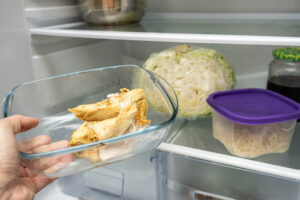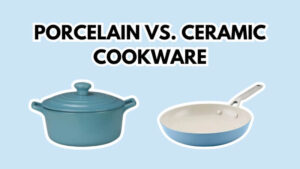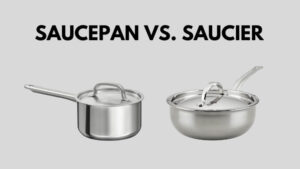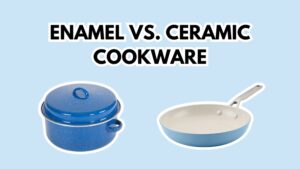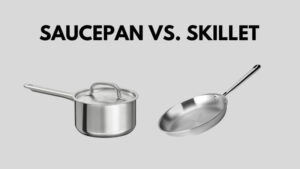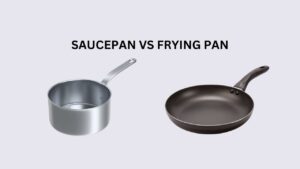Deciding between stainless steel cookware and nonstick cookware is a common dilemma for anyone looking to upgrade the kitchen. Both are popular choices, but they serve different purposes and suit different styles. Compare stainless steel cookware vs nonstick cookware to help you choose the best option.
What are the key differences?
Coating
The main difference between stainless steel and nonstick cookware lies in the coating or lack thereof. Nonstick cookware is typically coated with a layer made of PTFE, ceramic, or other materials, with some varieties being free of PFOA. These coatings prevent food from sticking to the surface, making them ideal for delicate cooking. In contrast, stainless steel cookware has no coating.
This distinction affects other stainless steel cookware vs nonstick aspects, such as cooking purpose, heat tolerance, durability, and maintenance.
Cooking purpose
When deciding between stainless steel vs nonstick cookware, understanding their cooking purposes can help you choose the right option.
Nonstick pans are fantastic for delicate dishes like eggs, pancakes, and fish. These foods need to slide off effortlessly without sticking. They’re also a fantastic choice for low-fat cooking, as they require little to no oil.
Stainless steel cookware excels in tasks that involve high heat, like searing, browning, or deglazing. It is also ideal for recipes that require transferring from the stovetop to the oven. For example, onion soup casserole, skillet cornbread, and frittatas.

Heat tolerance
One key difference is their ability to handle heat. Stainless steel cookware is able to withstand extremely high temperatures, so it is great for tasks like searing meats, stir-frying, or transferring directly to the oven.
Nonstick pans have a heat limit due to their coating, which can break down or release harmful fumes when exposed to excessive heat. They perform best at medium to low temperatures, making them ideal for cooking delicate foods.
Durability
Quality stainless steel pots and pans can endure years of heavy use without chipping, scratching, or warping. Unlike nonstick cookware, which requires careful handling to avoid damaging the coating, stainless steel is resilient to metal utensils and abrasive cleaning methods. While nonstick cookware needs to be replaced once the coating wears off, stainless steel cookware remains reliable for decades with proper care.
Maintenance
The former is known for its convenience, as the coating prevents food from sticking. Clean-up is easy with just a gentle wipe. However, nonstick cookware requires special care, including avoiding abrasive scrubbers and using non-metal utensils to preserve the coating.
Stainless steel cookware demands more effort during cleaning because food can stick to the surface if not cooked with the right techniques, such as pre-heating or using oil. How to clean stainless steel pans? You can soak it in soapy water, then use a non-abrasive sponge or cloth to scrub.
Stainless steel cookware is dishwasher-safe too! Sometimes, putting nonstick pans in dishwasher is also possible, but frequent dishwashing can degrade their coatings over time.

Suitable dishes
The type of cookware you choose plays a crucial role in how well your dishes turn out. Both stainless steel and nonstick cookware excel in different cooking scenarios, so it is important to match the right pan with the right dish.
Stainless steel cookware
Stainless steel cookware is particularly ideal for recipes that involve high heat, browning, or deglazing. The material’s ability to retain and evenly distribute heat makes it great for dishes that require precise control. For example, stainless steel pans are often the go-to choice for creating a crispy crust on pork chops, steaks, and chicken breasts. You can also use them to stir-fry vegetables, deglaze sauces and gravies, and pan-roast seafood.
Nonstick cookware
Nonstick pans, with their easy food release, are best for recipes where food could otherwise stick to the surface or burn. They are perfect for cooking eggs without them sticking, so scrambled eggs, fried eggs, or omelets. You can also use them for pancakes and crepes. The smooth surface ensures they slide off easily, providing a perfect golden-brown finish.

Additionally, cooking fish, like salmon or tilapia, is easier in a nonstick pan than a stainless steel one because the surface ensures the fish won’t break apart when flipping. Nonstick cookware needs little or no oil for cooking, making it ideal for low-fat or oil-free recipes as well. For instance, you can use a nonstick pan to stir-fry vegetables. Simply toss a variety of vegetables, such as bell peppers, broccoli, and snap peas, into the pan and cook them over medium heat without any oil.
Tips for using stainless steel and nonstick cookware
| Stainless steel cookware | Non-stick cookware |
| Preheat the pan: Before adding food, preheat your stainless steel pan over medium heat for best results | Cook at medium or low heat: High heat can damage the coating. This also prevents the release of harmful fumes |
| Use oil or butter: A bit of high smoke point oil, like avocado or grapeseed oil, evenly coat the surface, then pour it out and wipe with a tissue | Use wooden or silicone utensils: To preserve the nonstick coating, always use wooden, silicone, or plastic utensils and avoid metal ones |
| Avoid long, high-heat cooking: While stainless steel can withstand high heat, prolonged exposure to extreme temperatures can cause food to stick | Avoid cooking with oil and butter: While some oil is okay, nonstick cookware requires much less oil than other types. Excessive oil can leave residue |
| Clean immediately after use: To maintain the shiny appearance of stainless steel, clean your pan as soon as it cools down. Use a gentle scrubber to remove stubborn stains | Hand wash: Although some nonstick pans are labeled as dishwasher-safe, hand washing is recommended to prolong the life of the coating |
Conclusion
Choosing between stainless steel cookware and nonstick cookware ultimately depends on your cooking needs and preferences. Stainless steel is for high-heat cooking, searing, and recipes that require even heat distribution. On the other hand, nonstick cookware excels in convenience, offering easy food release and requiring little to no oil for cooking. If you’re also considering other materials for your cookware, such as aluminum, check out our comparison of aluminum vs stainless steel cookware for more insights.
By understanding the strengths and limitations of each, you can use the right cookware every meal. Whether you opt for the versatility of stainless steel or the ease of nonstick, both have their place in a well-equipped kitchen.



